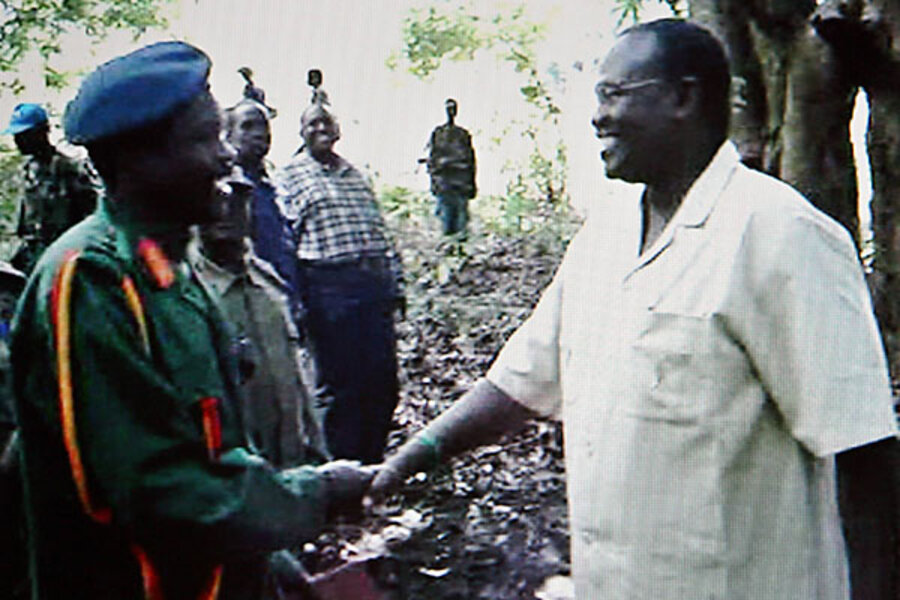Obama commits US to helping hunt for LRA leader Joseph Kony
Loading...
| Dungu, Democratic Republic of Congo
Lying on her hospital bed with her left arm heavily bandaged, three-year-old Suza Anipkidu is one of the Lord’s Resistance Army’s most recent victims.
Four days earlier, Suza, was following her grandfather, Samuel Mizalogbe, into the fields outside their village. That was when they came across the rebels.
Immediately they shot and killed her grandfather and another elderly man accompanying him. When Suza instinctively ran over to her grandfather’s body they spotted her and then shot her.
“They thought she was dead and so they left,” says her mother, Modestine Ngbadulezele, as she watches over her daughter as she recovers from the bullet wound. For the family, it’s not the first encounter with the LRA. In March, two relatives were abducted when the LRA attacked the village.
Attacks, such as this one, for the past 23 years, are why President Barack Obama signed a law Monday that commits the US to helping four African nations to bring an "end to the brutality and destruction," said Mr. Obama in a statement. "By any measure, [the LRA's] actions are an affront to human dignity."
Kony's trail of tears
Originally from neighboring Uganda, the LRA is led by Joseph Kony, self-proclaimed prophet who was indicted in 2005 for war crimes by the International Criminal Court (ICC). His followers have become infamous for mutilating their victims and abducting children to be used as porters, fighters, and sex slaves.
In December 2008, after Kony failed yet again to sign a peace deal with the Ugandan government, the Ugandan army spearheaded an all-out attack on the LRA’s bases deep in the jungles of northeast Congo.
The attack, partly funded and planned by the US, failed to kill Kony or his top commanders and the LRA splintered into small groups, surviving over the next 18 months by spreading into Central African Republic and Sudan – even reaching as far as Sudan’s Darfur region according to some reports.
Since then, the UN says, at least 1,616 people have been killed, many hacked to death with machetes, and over 1,800 people abducted in Congo alone.
While governments in the region claim that the ongoing military operations have severely weakened, if not destroyed, the LRA, recent attacks in Congo suggest the rebels retain some co-ordination, equipment and the ability kill on a large-scale. Estimates of the numbers of fighters left range from 100 to over 400.
Over four days of brutality in mid-December more than 321 people were killed and 250 abducted, Human Rights Watch says. 100 people were killed in January, according to the UN, and reports of more massacres in February are still being investigated.
Every month at Dungu hospital here, in the Democratic Republic of Congo (DRC), a steady stream of badly injured LRA victims arrive.
Since the end of last year these have included mutilated men, women and children; their lips, ears and noses sliced off as a warning to the local communities, says Jean Claude Amundala, a doctor at the hospital.
“These things sound unimaginable but they are a reality not science fiction. We have seen them,” says Dr. Amundala.
While Monuc, the UN’s billion-dollar-a-year peacekeeping operation in Congo, has boosted the number of its troops in the region to more than 1,000, LRA attacks continue to happen within 20 kilometers (12 miles) of the main base.
Still hunting the LRA
The Congolese Army, nominally charged with protecting civilians, has around 6,000 soldiers in the area but since elite troops were rotated out last year accusations of rapes and robberies by the army have rocketed and clashes between the military and LRA gone down. Elsewhere the Ugandan Army, while having officially ended operations in Congo and moved to Central African Republic, is still hunting the LRA down in the forests and vast expanses of Congo.
As the region's military try to succeed where others have repeatedly failed in capturing or killing Kony, one ray of hope is the Lord's Resistance Army Disarmament and Northern Uganda Recovery Act signed Monday by Obama. Passed by Congress earlier this month, the law would oblige the US to come up with a multi-faceted plan to stop the LRA threat. Africom, the US military's African command, has provided logistical support and intelligence to the Ugandan Army effort to hunt down the LRA.
While proponents argue that the law would place more emphasis on civilian protection and could see a more surgical attempt to take out Kony, skeptics claim it could help prolong current military operations and the suffering of the people on the ground.
But one thing almost everyone agrees on is that it’s time for a new strategy.
“Continuing with only this military strategy as it is will lead to nothing,” says Abbot Benoit Kinalengu, the head of a local church-based organisation for justice and peace back in Dungu. “Violence has and will only lead to violence.”
RELATED STORIES:
- Counterterrorism training to curb Al Qaeda threat in Africa
- Human Rights Watch says Lord's Resistance Army rampage killed 321 in the Congo
- Brutal retreat of LRA rebels in Congo
[Editor's note: "Lightning Thunder," a military operation lead by Ugandan forces, to capture Joseph Kony occurred in Dec. 2008. The original article had the wrong date]





